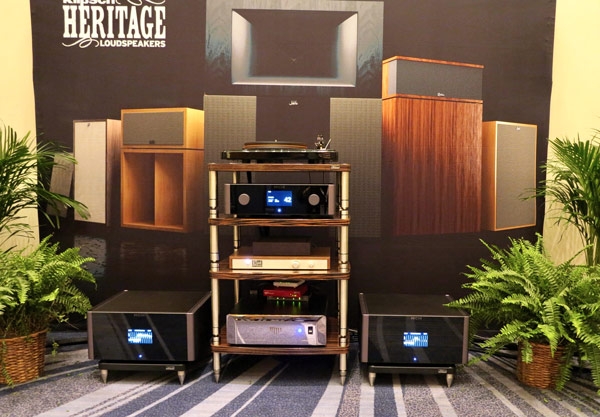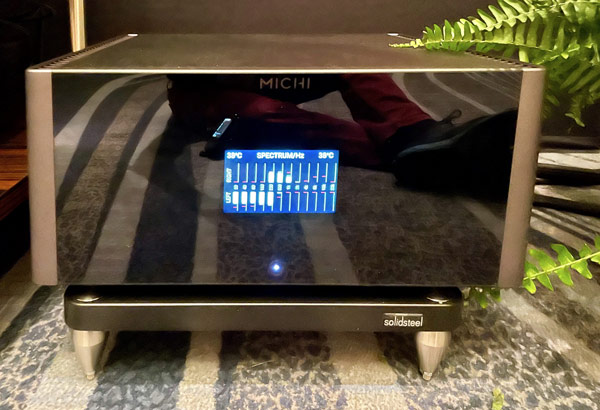| Columns Retired Columns & Blogs |
It's a shame that James Clerk Maxwell and Oliver Heaviside can't comment on the concept of "no characteristic impedance."

Strange as it may seem, this huge air-walled exhibit room's sponsor, AudioQuest with Abt Electronics of Chicago, was the mostly invisible partner that enabled Rotel's Michi P5 preamplifier with phonostage ($4299.99—follow-up coming in our August issue) and Michi S5 stereo power amplifiers ($7499/each—reviewing coming in our July issue) to sing through Klipsch Jubilee loudspeakers ($35,000/pair including outboard electronic crossover). That's a lot of parentheses in a single sentence, so let's parse it out a bit.

AudioQuest arrived in Chicago with big news: the completion of their Mythical Creatures (Dragon, Firebird, and Thunderbird) ZERO Tech cable line. According to AQ's extremely articulate Isaac Markowitz, the company's ZERO Tech topology produces power, speaker, and interconnect cabling with no characteristic impedance. "In an interconnect, Zero Tech linearizes noise dissipation and takes it into the megahertz and gigahertz range," he said. Because components never have matched impedance across all frequencies, and cable impedance rarely if ever matches the differing impedance of the components, removing characteristic impedance from cabling minimizes interactions and produces a far more direct connection. It also makes for easy compatibility between AudioQuest cables and those from other companies.
"Characteristic impedance is like a sponge," he continued. "Imagine water dripping into a sponge. The sponge must saturate before water can pass through it. With 'ZERO Tech,' we remove the sponge."
The new cable line, derived from Bill Low's initial technology and Garth Powell's subsequent technological advances, uses bespoke connectors. Thunderbird is comprised of perfect-surface copper and benefits from a proprietary annealing bath, perfected by Bill Low and George Cardas, that elongates metal grains. (Who says that competitors can't be friends?) The same bath is used for Firebird and Dragon, which are comprised of perfect-surface silver. The difference is in the drain: Firebird's drain is silver-plated, while Dragon's is 20-gauge silver. "Copper is more forgiving because it has less resolution," Markowitz said.

The proof is in the listening. With the Rotel Michi S5 (above) used in bi-amping configuration, as required by the Klipsch Jubilees, the system did a take-no-prisoners, no sponge-bath job on bass. Image size was huge as the system defied the constraints of an air-walled conference room. (Serious speaker toe-in helped.) The Jubilees are Paul Klipsch's final design and took 20 years to complete. They include a patented 7" titanium diaphragm compression tweeter with 5" voice-coil and brand new Tractrix horn design. The LF section is horn-loaded with dual 12" bass drivers.
While I was in the room, I heard music sourced from Qobuz and streamed through a Roon Labs Nucleus ($1459). But others heard what the Fender x MoFi PrecisionDeck turntable with Mobile Fidelity MasterTracker phono cartridge ($3495) can deliver.

It's a shame that James Clerk Maxwell and Oliver Heaviside can't comment on the concept of "no characteristic impedance."

I have several AQ cables, most of them are very good, also the Jitterbug.. so I do have lots of respect of AQ & Mr Low, but "No Characteristic Impedance", the sponge analogy, ... all difficult to take, compared to their previous attitude of being .. more in line with Physics as we know it from University.
Thinking about it.. even if impedance matching makes sense only far outside audible frequency range (in context of home hifi with rel short cable lengths and long wave lengths), there might be a point to it w.r.t. HF EM noise picked up from somewhere and, rather than allowing it to mess circuits, aim at smoothly dissipating same (e.g. by the source device's low output resistance?), but Zero Impedance (lets call it low impedance; how to design ZERO impedance at all, over wide frequency range??) means reflection rather than dissipation.. ahh.. not getting it. Or was reflection the aim??

Beats me. This is why I am not a famous cable designer. Not even an anonymous cable designer.
Since cable transmission of AC signals relies on propagating electromagnetic fields, which therefore implies an impedance, I don't get it at all.

Because Isaac Markowitz was in the dentist chair, I worked with Garth Powell by email to ensure that the copy was correct. With minimal editing, this is the final comment he shared:
"Zero impedance means no wire resistance (which is impossible). Zero characteristic impedance means the cable does not require a specific circuit input or output impedance to function at its best. Topology is correct for a cable and gets rid of a redundant term."
Previously, Garth had written: "The issue with any audio interconnect where both noise-dissipation and carrying the primary signal are concerned, is that by design, components never have matched impedance across all frequencies. To compound this necessary but somewhat unfortunate problem, cables also have their own characteristic impedance which is never that of either of the connected components. The result?: Inconsistent performance, particularly at low signal levels and with audio transients. Removing the characteristic impedance virtually eliminates this inherent mismatch from circuits to cable."
Garth also shared this tidbit:
"The new cables were built on the solid technological foundation established by Bill Low before my arrival at AudioQuest. However, every new technology and the implementation of all of these technologies and parts together is mine, including some proprietary burn-in technology (molecularly optimized stressing) of the finished cable we invested mightily in. For nearly 48 hours, these cables are subjected to over five times the voltage and current they could ever see in real-world use at top volume.
"Other burn-in machines do not and cannot employ this technology, as our machines and fixtures are huge and feature lethal voltages. These machines could never be made available to a dealer or the public as an accessory (far too dangerous). We call this process PMO (permanent molecular optimization)."

Wow! That's certainly going beyond the line of duty. I very much appreciate you passing this information along to us. I know that you're the messenger here.
At this point, I'm going to just stop my participation in the discussion and move on to other things in life.
Thank you again.